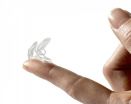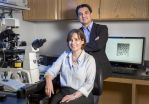(Press-News.org) LOS ANGELES (JUNE 8, 2015) - The witness on the stand says he saw the accused at the scene of the crime. Is he sure? How sure? The jury's verdict could hinge on that level of certainty.
Many decisions we make every day are influenced by our memories and the confidence we have in them. But very little is known about how we decide whether we can trust a memory or not.
A new Cedars-Sinai study provides some of the answers. Researchers have identified a unique set of neurons in the medial temporal lobe, an area of the brain where memories and memory-based decisions are processed. They show that the activity of these neurons is indicative of the confidence by which a memory will be retrieved. Findings are published in the June 8 online issue of Nature Neuroscience.
"The mechanisms that help us make confidence judgments about a memory-based decision are poorly understood, but we know they are impaired by many different diseases and disorders," said Ueli Rutishauser, PhD, assistant professor of neurosurgery and director of human neurophysiology research at Cedars-Sinai, the article's lead author.
Some people with amnesia, for example, are overconfident in their decision-making, while others are aware of their poor memories and are able to weigh their judgments accordingly. To start developing treatments for amnesia, researchers need to understand the brain's ability to assess the quality of memories, which is a key component of the memory-making and retrieving process, added Rutishauser, a research scientist in the Neurosurgery Department and Neurology Department.
"Because memory and judgment processes impact our everyday lives, we want our confidence level to be an accurate reflection of reality," he said. "This study has given us a better understanding of the way certain neurons influence memories, confidence in those memories and decision-making."
Recording the electrical activity of 1,049 individual nerve cells, the researchers discovered differences between two groups of neurons in the brain's medial temporal lobe. One group - visually selective cells - simply reports what is being seen, such as a car, a tree, a dog or a house. These neurons give a running commentary on the environment, but they only respond to stimuli, regardless of whether or not the individual has seen an object before.
In contrast, the second group - memory-selective cells - appears to be directly involved in memory retrieval and confidence. This group consists of two subgroups: familiarity neurons and novelty neurons. When a person sees something familiar, like their own dog, familiarity neurons are stimulated. When a person sees something new, like a different dog, activity of novelty neurons increases.
The key finding was that the strength of the familiarity and novelty neurons' activity was proportional with confidence: the larger the increase in activity, the more confidence people expressed that their decision was correct. By correlating strength of signals to patients' responses, the researchers gained insight into the formation of memories and the way people perceive them.
"Our study shows for the first time that visually selective cells are not influenced by memory. In fact, they are functionally and, we believe, anatomically distinct from memory-selective cells," said Adam Mamelak, MD, senior author, professor of neurosurgery and director of functional neurosurgery in the Neurosurgery Department. "Defining these differences is important because it may help us target one cell but not another. We currently have no treatment to offer for failing memory, but as treatments are developed, we will want to be extremely selective in which neurons are stimulated and which are not."
Patrick Lyden, MD, chair of the Neurology Department, and Keith Black, MD, chair of the Neurosurgery Department, said the findings are a significant advancement that could only be accomplished through the combined efforts of neurology and neurosurgery clinicians working closely with neuroscientists. The other vital ingredient, they said, are patients who volunteered to extend the frontiers of science.
Twenty-eight patients with epilepsy took part in the study. They were hospitalized for diagnostic procedures, including implantation of deep-brain electrodes to precisely locate the source of seizures. This gave investigators the rare opportunity to observe the electrical activity of individual brain cells while patients performed a recognition memory test, identifying sequences of images as seen before or not, and rating their confidence in their choices.
INFORMATION:
Study contributors included: Jeffrey Chung, MD, director of the Epilepsy Program and the Electrophysiology Laboratory at Cedars-Sinai; Ian Ross, MD, a neurosurgeon at Huntington Memorial Hospital; Shengxuan Ye and Matthieu Koroma, visiting graduate students at Cedars-Sinai; and Oana Tudusciuc, a Caltech researcher doing postdoctoral work at Cedars-Sinai.
The Cedars-Sinai Department of Neurosurgery, the National Institute of Mental Health Conte Center at Caltech and the Pfeiffer Research Foundation provided funding.
Citation: Nature Neuroscience, "Representation of retrieval confidence by single neurons in the human medial temporal lobe," available online June 8, 2015. http://www.nature.com/neuro/journal/vaop/ncurrent/full/nn.4041.html
Video Interview with researchers: https://youtu.be/Jl-xNXHMntA
The use of camera traps -- remote automatic cameras triggered by heat or motion -- has revolutionized wildlife ecology and conservation research. But the large number of images generated through the traps creates the problem of categorizing and analyzing all the images.
For a recent project conducted in the Serengeti National Park, Alexandra Swanson, turned to another relatively new technology -- a citizen science platform. The Snapshot Serengeti project asked non-scientist volunteers to review 1.2 million sets of images. A description of the project, 'Snapshot Serengeti, ...
A variety of factors including questions about risk and reluctance to offend patients limits clinician willingness to prescribe a potentially life-saving medication that counteracts the effects of an opioid overdose, according to a Kaiser Permanente Colorado study published today in the Journal of General Internal Medicine.
The number of fatal overdoses from opioid medications has quadrupled in the U.S. since 1999. According to the Centers for Disease Control and Prevention (CDC), each day 44 people die of prescription painkiller overdoses. In the event of an overdose, ...
American physicians with waivers allowing them to provide office-based medication-assisted buprenorphine treatment to patients addicted to opioids were able to increase potential access to effective medication-assisted treatment by 74 percent from 2002 to 2011, according to a new RAND Corporation study.
Published in the June issue of the journal Health Affairs, the study shows that the increased number and geographic distribution of physicians obtaining waivers to prescribe buprenorphine has widened potential access to effective treatment for those with addiction to heroin ...
Getting through the pollen season can now become easier for some of the approximately 500 million people worldwide who suffer from sneezing and a runny nose, watery eyes and drowsiness during the allergy season (seasonal allergic rhinitis).
This is indicated by a controlled trial carried out by researchers from Aarhus University. The trial, which took place over two days, included 65 people with grass pollen allergies who were not receiving any medical treatment at that time. They were either equipped with a nasal filter or a placebo device.
The conclusion was that the ...
Chicago, June 9, 2015 - A more aggressive approach to treating degenerative mitral valve disease, using earlier surgical intervention and less invasive techniques, is more beneficial to the patient than "watchful waiting," according to an article in the June 2015 issue of The Annals of Thoracic Surgery.
Key points
Earlier surgical intervention using less invasive surgical techniques is better than watchful waiting for patients with degenerative mitral valve disease.
Over the 25 years observed, mortality rates remained low, hospital length of stay was shorter, ...
Athens, Ga. - Researchers in the University of Georgia's Regenerative Bioscience Center are visually capturing the first process of chromosome alignment and separation at the beginning of mouse development. The findings could lead to answers to questions concerning the mechanisms leading to birth defects and chromosome instability in cancer cells.
"We've generated a model that is unique in the world," said Rabindranath De La Fuente, an associate professor in the UGA College of Veterinary Medicine. "Because we removed ATRX protein expression only in the oocyte, the female ...
The handling of agricultural crop residues appears to have a large impact on soil's ability to retain carbon, making land management practices increasingly important, especially under a scenario where cellulosic materials become more heavily used as a feedstock for ethanol production, according to a recently published study led by researchers at the U.S. Department of Energy's Argonne National Laboratory.
"Plants and soil are carbon sinks," said Argonne climate scientist Beth Drewniak, who led the study. "Soils lock carbon away for long periods of time. But when plant ...
Computers and water typically don't mix, but in Manu Prakash's lab, the two are one and the same. Prakash, an assistant professor of bioengineering at Stanford, and his students have built a synchronous computer that operates using the unique physics of moving water droplets.
The computer is nearly a decade in the making, incubated from an idea that struck Prakash when he was a graduate student. The work combines his expertise in manipulating droplet fluid dynamics with a fundamental element of computer science - an operating clock.
"In this work, we finally demonstrate ...
One potential way to combat ongoing climate change, eliminate air pollution mortality, create jobs and stabilize energy prices involves converting the world's entire energy infrastructure to run on clean, renewable energy.
This is a daunting challenge. But now, in a new study, Mark Z. Jacobson, a professor of civil and environmental engineering at Stanford, and colleagues, including U.C. Berkeley researcher Mark Delucchi, are the first to outline how each of the 50 states can achieve such a transition by 2050. The 50 individual state plans call for aggressive changes ...
For the past several years, Anthony Wagner has been developing a computer program that can read a person's brain scan data and surmise, with a high degree of certainty, whether that person is experiencing a memory. The technology has great promise to influence a number of fields, including marketing, medicine and evaluation of eyewitness testimony.
Now, Wagner, a professor of psychology and neuroscience at Stanford, and his colleagues have shown that with just a little bit of coaching and concentration, subjects are easily able to obscure real memories, or even create ...

